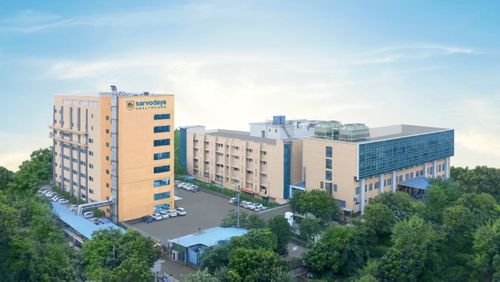Overview
We provide heart pacemaker implants in Faridabad, Delhi NCR, to treat slow or irregular heartbeats, helping patients regain a steady and active life. A pacemaker is a small device placed under the skin that sends gentle electrical signals to maintain a regular heart rhythm.
Our experienced team ensures precise diagnosis, advanced imaging, and expert care throughout the process, from evaluation to implantation and ongoing aftercare, for a safe and smooth recovery.
Why is pacemaker implantation required?
We recommend a pacemaker when the heart’s electrical system cannot maintain a safe rhythm and symptoms begin to affect daily life. This is common in symptomatic bradycardia that causes dizziness, fainting, fatigue, or breathlessness.
It is also used in atrioventricular blocks where signals from the upper to lower chambers are delayed or interrupted.
Conduction problems after a heart attack or certain procedures, and rhythm issues caused by medicines that cannot be adjusted, may also require pacing support.
If cardiac pacemaker implantation is right for you, we explain the reasons, the device best suited to your needs, and how it will support day-to-day living.
Procedure of Pacemaker Implantation
We begin with a thorough assessment, reviewing your medical history, ECG, Holter monitor, echocardiogram, and blood tests. On the day of the pacemaker procedure, most implants are performed under local anaesthesia with light sedation so you remain comfortable.
The cardiologist makes a small incision below the collarbone and guides soft leads into the heart using X-ray imaging before connecting them to a small generator placed under the skin.
We test the lead positions and device settings to ensure reliable pacing and sensing, then close the incision with fine sutures.
Most patients return home within 24–48 hours with simple wound care instructions and a clear follow-up plan. This is a minimally invasive pacemaker implant surgery focused on precision and comfort.
Technology and infrastructure
We combine high-precision diagnostics with modern cardiac theatres to support safe, predictable outcomes. Fluoroscopy-guided implantation uses low-dose protocols to minimise exposure.
We offer single- and dual-chamber systems and MRI‑conditional pacemakers where indicated, with temporary pacing support available for high-risk cases.
Continuous ECG and haemodynamic monitoring are used during and after the procedure. On-site echocardiography, stress testing, and laboratory services streamline the evaluation.
Benefits of Pacemaker Implantation
Choosing pacemaker implantation at our heart care centre ensures reliable rhythm control with minimal lifestyle disruption. It restores energy, prevents rhythm-related risks, and supports long-term cardiac well-being.
- Restores Steady Heart Rhythm: Corrects irregular heartbeats, reducing dizziness, fainting, and overwhelming fatigue so you feel stable and safe in daily life.
- Improves Exercise Tolerance: Enhances stamina and energy levels, allowing you to walk, climb stairs, and enjoy activities without constant tiredness or shortness of breath.
- Boosts Confidence & Independence: Reduces fear of sudden blackouts or falls, helping you regain confidence and live more freely without constant worry.
- Faster Recovery: Small incision and short hospital stay ensure minimal discomfort, quicker healing, and an earlier return to normal activities.
- Customised Settings: Device is programmed to match your heart’s needs during rest and activity, with adjustments possible as lifestyle or health changes.
- Reduces Fall & Injury Risk: By maintaining a steady rhythm, pacemakers lower the chance of collapse, falls, or rhythm-related accidents.
- Supports Long-term Lifestyle: Encourages a more active, fulfilling life with reduced limitations, while keeping your heart rhythm under consistent monitoring.
- Transparent Guidance: We clearly explain benefits, limitations, and alternatives, ensuring you feel informed and supported in making the safest treatment decision.
Post-Treatment Lifestyle Modifications After Pacemaker Implantation
Recovery after a pacemaker procedure is gradual and personalised. At Sarvodaya Hospital, our expert cardiologists guide you with clear steps to protect your heart and device.
- Wound Care and Incision Management: Keep the surgical site clean and dry. Watch for redness, swelling, discharge, or fever, and immediately report these symptoms to your doctor.
- Gentle Movement and Physical Activity: Avoid lifting your implant-side arm above shoulder height for two weeks. Begin with daily walks, gradually increasing activity, but avoid heavy lifting for 4–6 weeks.
- Medication Adherence: Take prescriptions as directed without skipping doses. Always carry a complete list of your medicines and share it with your cardiologist at every appointment.
- Device Safety and Precautions: Maintain a 15 cm distance between the pacemaker and phones or headphones. Use the opposite ear during calls to minimise electromagnetic interference.
- Travel and Identification: Carry your pacemaker card at all times. Inform airport security about your device and avoid handheld metal detectors directly over the implant site.
- Healthcare Communication: Always tell doctors, dentists, and healthcare providers about your pacemaker before undergoing any medical tests or procedures to ensure safety.
- Regular Device Monitoring: Attend scheduled follow-ups so our specialists can fine-tune settings, check battery status, and ensure your pacemaker is functioning optimally.
- Warning Signs to Watch: Seek urgent medical care if you experience chest pain, fainting, palpitations, breathlessness, or sudden swelling at the implant site.





